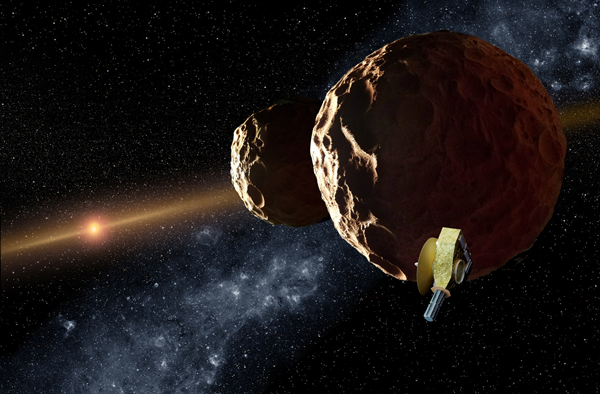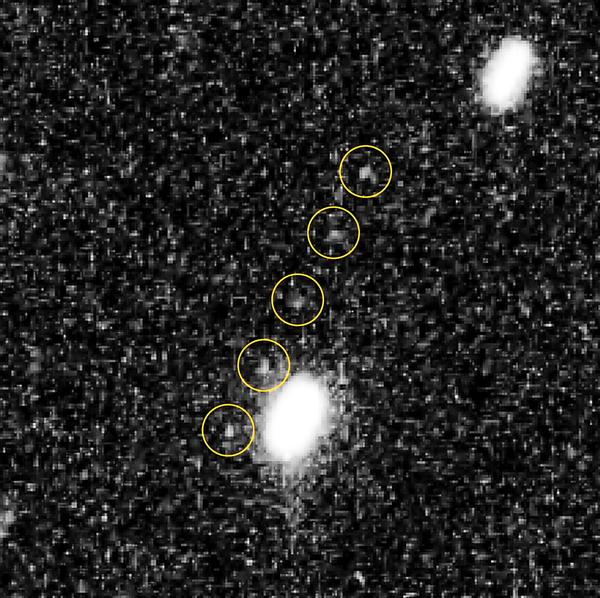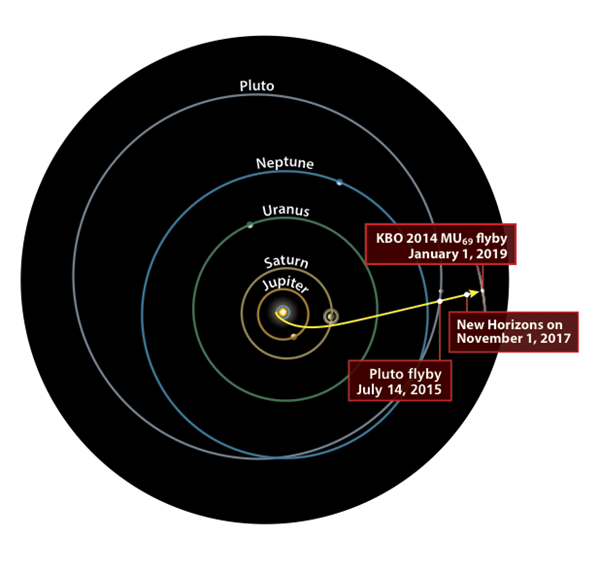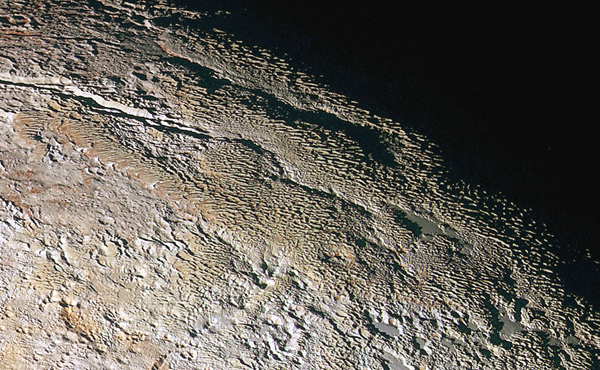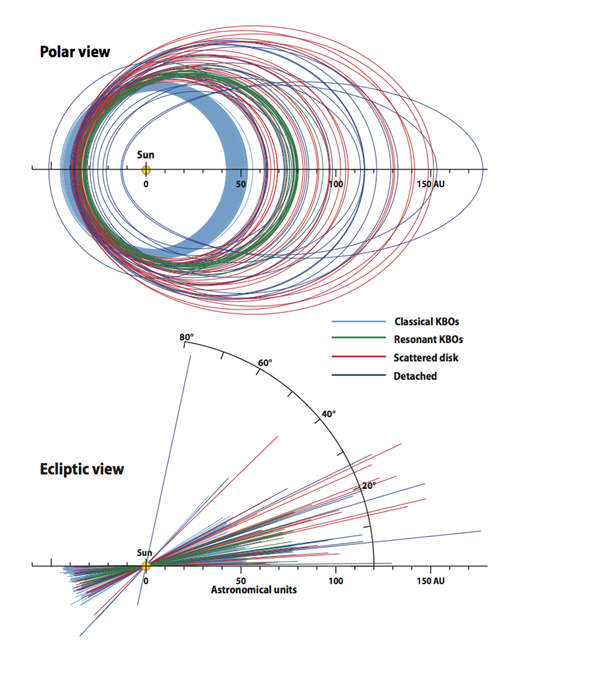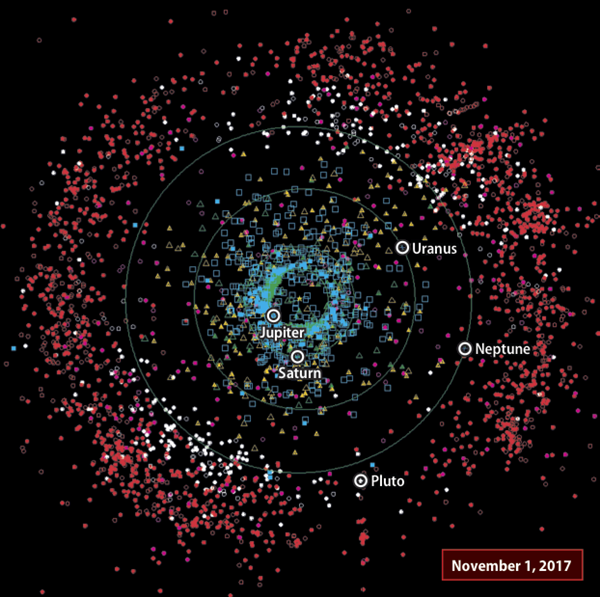New Horizons is NASA’s Pluto and Kuiper Belt exploration spacecraft. After a four-year-long development, the sophisticated probe was launched in January 2006. In 2015, New Horizons conducted the first close-up exploration of Pluto and its five moons, revolutionizing our knowledge of that system. As principal investigator of the mission, I chronicled the amazing results from that flyby in Astronomy in November 2015, May 2016, and September 2017.
But the New Horizons team designed and built the spacecraft to do more than just explore the Pluto system. The spacecraft is forging ahead, conducting a new, NASA-approved and funded, five-year extended mission. The Kuiper Extended Mission (KEM) will explore the vast Kuiper Belt and numerous bodies in it — most notably, the first-ever flyby and close-up study of an ancient Kuiper Belt object (KBO).
KEM began in late 2016 and will stretch into mid-2021. Its centerpiece is the flyby of the KBO 2014 MU69 (“MU69” for short). Once there, New Horizons will have set two more records: the most distant flyby in the history of space exploration (a billion miles beyond Pluto) and the longest flight time of any space mission to reach a previously unvisited target (13 years).
In addition to exploring MU69, KEM will study the Kuiper Belt in several other ways. These include observations of more than two dozen other KBOs, most at distances 50 to 100 times closer than Earth-based or Earth-orbiting studies allow. New Horizons also will explore the dust, gas, and plasma environment of the Kuiper Belt with sophisticated sensors that far outstrip the capabilities of Pioneers 10 and 11 and Voyagers 1 and 2 when they crossed this region of space in the 1980s and 1990s.
The Kuiper Belt and MU69
The discovery of the Kuiper Belt in the 1990s transformed the understanding of our home solar system. This breakthrough rewrote the textbooks about the solar system’s geography, showing the planetary realm is not simply a two-zone system of inner planets and outer planets, but a three-zone system with inner planets surrounded by a region of gas giants, which are surrounded by a wide disk containing comets, planetary building blocks called planetesimals, and a bevy of small planets like Pluto.
With the discovery of the Kuiper Belt, the gas giants were relegated from being the “outer planets” of old to being the planets of the middle solar system. The discovery also revolutionized our understanding of the population structure of the solar system, showing Pluto is not a lone misfit world beyond the giant planets but instead the first known member of a large population of small planets that dwarf the number of terrestrial and giant planets combined.
The New Horizons team found MU69 during a dedicated search for post-Pluto flyby targets using NASA’s Hubble Space Telescope in 2014. MU69 hasn’t received a name beyond its discovery designation yet, but it’s coming, through a public naming contest that the New Horizons project and NASA conducted in late 2017.
MU69 travels in a nearly circular, 296-year-long orbit centered at 44.4 astronomical units. (An astronomical unit is the average distance between the Sun and Earth.) Its orbit inclines just 2.5° relative to the plane of the solar system. Astronomers now know MU69’s orbit well enough that it has received an official minor planet number, 486958, from the International Astronomical Union’s Minor Planet Center.
Because MU69 is so faint (at an apparent visual magnitude of 26.8), little is known about it other than its diameter, which is between 12 and 25 miles (20 and 40 kilometers), and its color, which is somewhat redder than Pluto. MU69 belongs to a Kuiper Belt subpopulation called cold classical KBOs — ancient objects that have always been members of the Kuiper Belt. They are distinct from other KBO subpopulations that formed among the giant planets and then were ejected to the Kuiper Belt. Because MU69 formed in situ in the Kuiper Belt, it represents a highly valuable, “bedrock” sample of the material in the solar nebula at its great distance from the Sun.
MU69 possesses another valuable trait: Its diameter falls nicely between comets, which typically are a couple of miles across, and small outer solar system planets like Pluto — 600 to 1,500 miles (1,000 to 2,500 km) across. Comparing MU69’s surface features, interior structure, and composition with smaller and larger bodies from the Kuiper Belt will allow us to better understand the accretion processes that built small planets there, like Pluto, Quaoar, Orcus, Ixion, Eris, and Sedna.
Many small KBOs have satellites, but we do not yet know definitively whether MU69 does, though results from stellar occultations last summer indicate it could be a binary. And because MU69 is so faint, even the largest telescopes on Earth or in Earth orbit cannot study it spectroscopically, so its composition is completely unknown.
Challenges ahead
In October and November 2015, shortly after our exploration of Pluto, we fired the engines aboard New Horizons to retarget its trajectory to intercept MU69. That flyby will take place January 1, 2019, less than a year from now. That flyby date will set yet another record: the shortest time between the discovery of an object and its exploration by spacecraft (4.5 years). That’s barely 1 percent of an MU69 orbital period from discovery to exploration!
The flyby presents many challenges. One is simply hunting down MU69 to perform the intercept. Because it is so faint, no ground-based telescope has ever seen MU69; only Hubble has. And it is too faint for New Horizons to detect until about 100 days before we fly past, so we must rely on Hubble for all our tracking until fall 2018 when we are on final approach.
To determine MU69’s orbit, we combine the accurate astrometric measurements of MU69 from Hubble with the incredibly precise stellar positions delivered by the European Space Agency’s (ESA) Gaia astrometry satellite. Using these two sources and optical navigation data that New Horizons will obtain in 2018’s final months, we plan to target our spacecraft to a closest approach just 2,175 miles (3,500 km) above MU69 — about four times closer than we flew past Pluto. This means we’ll get images with about four times higher resolution!
Another challenge is that MU69 might be a binary. Scientists have found many binaries among the more than 1,500 known KBOs, and the number of cold classical KBOs that are binary tops 30 percent. But even Hubble cannot detect close binaries at MU69’s great distance. As I noted earlier, however, we did receive tantalizing hints that this might be the case July 17, 2017, when MU69 passed in front of a distant star. Ground-based observations of this occultation show it is either a close binary, two objects in contact with each other, or a single, highly elongated object with a big chunk taken out of it. We likely won’t confirm whether MU69 is a binary until New Horizons is on its final approach.
The object’s possible binary nature challenges us to plan searches for any other moons on approach, and to include in our flyby plans observations of those moons we might discover. If MU69 does have moons, their gravity may create a noticeable wobble in the position of our main target that can help us determine MU69’s mass and density.
Yet another challenge involves the possibility of hazards caused by rings or other orbiting debris that MU69 may have. Such debris would destroy New Horizons as it whips through at almost 33,000 mph (53,000 km/h). The recent discoveries of rings around the former KBO Chariklo, which now orbits among the giant planets, and the KBO Haumea make us all the more aware of this risk.
On top of these challenges, during the flyby we will have to operate the spacecraft with a 12-hour round-trip light-travel time (compared with nine hours at Pluto). This means that any ground-control intervention due to anomalies or the need for course corrections can only occur 12 hours or more after we determine the need for such actions.
Flyby plans maturing
Flyby operations will begin in late August and September 2018. That’s when we’ll make our first navigation images to search for our target using New Horizons’ Long Range Reconnaissance Imager (LORRI) telescopic CCD camera. We will regularly image MU69 during the final months of the approach to determine the need for up to six possible engine firings to accurately target the intercept.
We will also conduct long-exposure, deep LORRI imaging as we approach the target to search for satellites and rings — both for their scientific value as well as to spot any hazards to flight they could pose. As a precaution, we are planning a more distant flyby 6,000 miles (10,000 km) from MU69 as a backup. Still closer than the Pluto flyby, this alternative trajectory is likely to be beyond the range of any significant hazards that might orbit MU69.
In addition to its navigation and hazard-search tasks, LORRI will be used to determine MU69’s period from its light curve as we approach during fall 2018.
MU69 is probably 10 times larger and perhaps 1,000 to several thousand times more massive than comets like 67P/Churyumov-Gerasimenko, which ESA’s Rosetta mission orbited from 2014 to 2016. This means there’s likely to be a lot more variation in MU69’s surface geology than on comets like 67P, and perhaps a greater likelihood that it once was (or even now could be) active.
Despite its massive size relative to comets explored with spacecraft, MU69 is tiny compared with Pluto and will remain but a dot in our onboard cameras until just under two days before the flyby. So almost all of the science, and certainly all of our high-resolution studies of MU69, will take place virtually overnight as we fly past it on New Year’s Eve 2018 and New Year’s Day 2019. This is much different from our more-forgiving Pluto flyby, which enjoyed about 10 weeks of increasingly better imaging as we approached.
Seeing a KBO up close and personal
During our close-up of MU69, New Horizons will use all seven of its payload instruments to study it in detail. Our impact detector will search for orbiting dust. Our plasma instruments, called SWAP and PEPSSI, will search for evidence of outgassing and will study how MU69 interacts with the solar wind. Our ultraviolet spectrometer, called Alice, will search for evidence of a gas coma around MU69 and will take ultraviolet spectra of its surface for comparison to comets, asteroids, and icy moons. Meanwhile, our radio science instrument, REX, will attempt to take MU69’s temperature and measure its radar reflectivity using a powerful X-band transmission from NASA’s Deep Space Network antennas on Earth.
But the biggest highlights of our MU69 observing campaign will come from the mapping instruments: LORRI, the high-resolution, panchromatic, visible-light imager mentioned earlier, and Ralph, a composition and color mapper. If we are able to fly within 2,175 miles (3,500 km) of MU69, as is our baseline plan, LORRI will obtain resolutions as good as 100 feet (30 meters) per pixel, allowing us to make maps with up to half a million pixels or more and spot building-sized boulders, craters, and other features. We didn’t get anything close to that resolution on Pluto or any of its moons.
LORRI also will be able to search for satellites of MU69 down to diameters of perhaps half a mile (1 km) or so. That’s much smaller than even the tiniest of Pluto’s moons, Styx, which measures 10 by 5 by 6 miles (16 by 8 by 9 km). In addition, LORRI and Ralph will map MU69 in stereo, allowing us to make digital elevation maps to puzzle out its 3-D shape, structure, and geology.
Going beyond geology, Ralph will explore MU69’s surface properties and composition in several ways. This will include color imaging at a resolution near 1,600 feet (500 m) per pixel, and infrared composition mapping to determine the distribution of ices and some minerals across its surface at about half this resolution. These observations will yield a composition map at up to 1,000 locations across the surface. Ralph and LORRI also will study MU69’s surface properties by imaging it from a range of angles, allowing us to ascertain the microphysical properties of its surface “soil,” including how much light it reflects and how porous it is.
If LORRI discovers any satellites, we’ll use Ralph data to attempt measurements of their color and composition, though the feasibility of these observations depends on where the satellites are in their orbits near the time of closest approach.
After the MU69 flyby, New Horizons will begin to send back images and other data immediately, with close-up images returning to Earth starting the next day. Because of the low data rates imposed by the spacecraft’s mere 30-watt transmitter and its great distance from Earth (more than 4 billion miles, or 6.5 billion km), the entire treasure-trove of data will take up to 22 months to downlink to Earth. This should wrap up in the late summer or early fall of 2020.
The data will revolutionize our knowledge of this ancient planetary building block and, by extension, transform the study of small KBOs from point-source astronomical observations to detailed exploration. Sadly, in addition to being the first-ever flyby of an ancient KBO, it also may be the last for several decades — no mission to the Kuiper Belt is on the books.
An observatory in the Kuiper Belt
Will New Horizons make any other close flybys after MU69? We won’t have much fuel to target another flyby unless we get lucky, but we’re searching for targets in case one fortuitously falls along our path.
Whether or not that happens, New Horizons will act as an observatory in the Kuiper Belt until at least 2021, studying many other KBOs with LORRI through the end of the current KEM. In all, we will examine more than two dozen KBOs — small and large — in ways that no telescope on Earth can. Not even Hubble or its successor, the James Webb Space Telescope, can perform this work. These observations will enable us to determine the shapes of small KBOs for the first time, make higher-resolution searches for close-in satellites of KBOs than before, and study the surface properties of these bodies. All of these will provide critical context for how MU69 compares with its cohorts in the Kuiper Belt.
After the MU69 flyby, New Horizons also will continue to map the properties of the Sun’s distant heliosphere with its ultraviolet spectrometer and its plasma and dust sensors. These instruments are far more sensitive than those on previous spacecraft that flew through this region.
Onward, ever onward
New Horizons and its payload sensors are healthy and operating perfectly. It has enough power and fuel to operate for perhaps up to about 20 more years, allowing it to study in new ways the heliosphere’s outer fringes and perhaps even its boundary with interstellar space.
Even more exciting is the possibility that we can dramatically augment New Horizons’ capabilities by uploading new software for observing and onboard data reduction once we no longer need the flyby software. If NASA someday approves this plan, New Horizons can survey the Kuiper Belt population in ways that no other mission, or any telescope on Earth or in Earth orbit, can.
Additionally, we’ve seen interest in the astrophysical community for New Horizons to conduct some kinds of visible, infrared, and ultraviolet observations that can’t otherwise be performed from near Earth. Examples include studies of extragalactic background light, the zodiacal light, and microlensing, as well as long-term monitoring of variable stars.
Just think: After we complete the MU69 flyby data downlink, we could literally re-create and reinvent New Horizons, creating a powerful planetary astronomy, astrophysical, and heliospheric observatory traversing the Kuiper Belt and regions beyond through the 2020s and 2030s!
S. Alan Stern of the Southwest Research Institute in Boulder, Colorado, is a planetary scientist and the principal investigator of NASA’s New Horizons.

